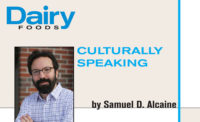When you read the word lactose, what do you think? Does the processor in you wonder what you’ll do with so much of it? Does the marketer in you wish of ways to be free of it? Does the consumer in you feel a little bloated? Do you think of lactose as an opportunity or a problem for your business? I suspect that for many of you dear readers, it is the latter.
Here’s the thing: Lactose is the major non-water component of milk; it is the evolutionary chosen nutritional carbohydrate for human development and growth. Yes, three out of four of us globally develop some level of lactose intolerance as we age. While this is a challenge for lactose utilization, are we repeating a mistake? Like milk fat — another dairy component we once actively removed from many products and one that researchers have come to realize have potential benefits — perhaps milk sugar represents another valuable opportunity we as an industry are missing.
A gut check on lactose
I still remember how the evening would turn out when my college roommate dared dairy because he forgot to bring along a little pill of Lactaid. It was so uncomfortable for him, it even made a headline in the local paper. Looking back, did his enjoyment of a sundae have to rest on fickle memory? Research suggests maybe not.
Studies are showing that lactose and lactose-derived carbohydrates such as galactooligosaccharides (GOS) can positively influence gut health. These nutrients can promote the growth of beneficial species of bacteria such as Bifidobacterium and Lactobacilli that can then, as they establish themselves and produce the right enzymes, aid in the comfortable digestion of lactose. The growth of these bacterial strains also seems to result in reductions in less desirable species such as Clostridia and Bacteriodes.
Other studies suggest that regular consumption of certain strains of Bifidiobacterium and Lactobacilli themselves can also reduce the severity of lactose intolerance and improve gut health. A full glass of lactose is likely too much discomfort for anyone to patiently cultivate a shift in their gut, but conversely, the rise of lactose-free options won’t help this problem either.
Perhaps there is a space for new dairy products that feature reduced lactose, are GOS-fortified, contain the right bacterial culture, or a combination of all three, to seed the transformation. These new products would not only drive improved consumer health, but also naturally open routes for further enjoyment of dairy products without anyone having to remember their pillbox.
Refreshing lactose
Every block of cheese, scoop of whey protein and cup of Greek yogurt result in pounds of leftover lactose. The rise of ultrafiltration to preconcentrate protein may reduce the downstream lactose left over from these products, but it’s really a mass balance shell game, with lactose just produced earlier. As dairy product consumption increases globally, so will lactose production. The question remains what do with it.
Dairy beverages, with their high protein content, are typically considered to be satiating, not refreshing for a hot day. Lactose-based fermented beverages could open up that refreshment occasion.
Take kefir, a fermented dairy beverage with cultures that have started jumping ship into water. Water kefir uses our dairy cultures to ferment plant-based sugars to create bubbly, refreshing beverages that are taking on carbonated soft drinks. There is no reason that these new fermented categories, and others such as kombucha, couldn’t leverage the industry’s plethora of dairy-based sugars to drive beverage innovation in the marketplace.
Now I’m pretty confident that 2019 is not the year of lactose, but if it were, dear reader, it would probably be too late for you to take advantage of it. However, lactose is an opportunity to promote health and innovation for dairy, and it’s just waiting to be taken. Here’s to 2020.


